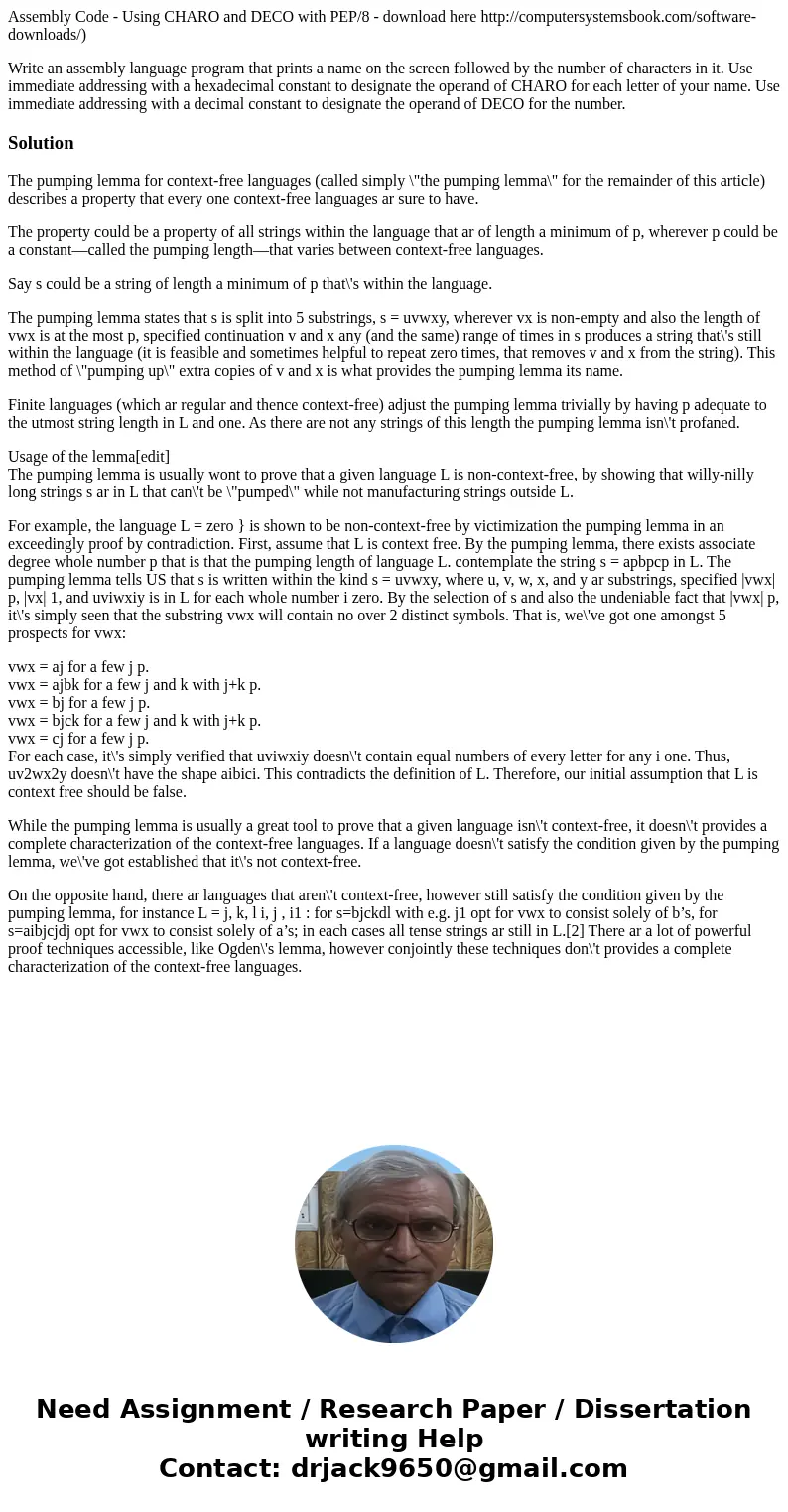Assembly Code Using CHARO and DECO with PEP8 download here
Assembly Code - Using CHARO and DECO with PEP/8 - download here http://computersystemsbook.com/software-downloads/)
Write an assembly language program that prints a name on the screen followed by the number of characters in it. Use immediate addressing with a hexadecimal constant to designate the operand of CHARO for each letter of your name. Use immediate addressing with a decimal constant to designate the operand of DECO for the number.
Solution
The pumping lemma for context-free languages (called simply \"the pumping lemma\" for the remainder of this article) describes a property that every one context-free languages ar sure to have.
The property could be a property of all strings within the language that ar of length a minimum of p, wherever p could be a constant—called the pumping length—that varies between context-free languages.
Say s could be a string of length a minimum of p that\'s within the language.
The pumping lemma states that s is split into 5 substrings, s = uvwxy, wherever vx is non-empty and also the length of vwx is at the most p, specified continuation v and x any (and the same) range of times in s produces a string that\'s still within the language (it is feasible and sometimes helpful to repeat zero times, that removes v and x from the string). This method of \"pumping up\" extra copies of v and x is what provides the pumping lemma its name.
Finite languages (which ar regular and thence context-free) adjust the pumping lemma trivially by having p adequate to the utmost string length in L and one. As there are not any strings of this length the pumping lemma isn\'t profaned.
Usage of the lemma[edit]
The pumping lemma is usually wont to prove that a given language L is non-context-free, by showing that willy-nilly long strings s ar in L that can\'t be \"pumped\" while not manufacturing strings outside L.
For example, the language L = zero } is shown to be non-context-free by victimization the pumping lemma in an exceedingly proof by contradiction. First, assume that L is context free. By the pumping lemma, there exists associate degree whole number p that is that the pumping length of language L. contemplate the string s = apbpcp in L. The pumping lemma tells US that s is written within the kind s = uvwxy, where u, v, w, x, and y ar substrings, specified |vwx| p, |vx| 1, and uviwxiy is in L for each whole number i zero. By the selection of s and also the undeniable fact that |vwx| p, it\'s simply seen that the substring vwx will contain no over 2 distinct symbols. That is, we\'ve got one amongst 5 prospects for vwx:
vwx = aj for a few j p.
vwx = ajbk for a few j and k with j+k p.
vwx = bj for a few j p.
vwx = bjck for a few j and k with j+k p.
vwx = cj for a few j p.
For each case, it\'s simply verified that uviwxiy doesn\'t contain equal numbers of every letter for any i one. Thus, uv2wx2y doesn\'t have the shape aibici. This contradicts the definition of L. Therefore, our initial assumption that L is context free should be false.
While the pumping lemma is usually a great tool to prove that a given language isn\'t context-free, it doesn\'t provides a complete characterization of the context-free languages. If a language doesn\'t satisfy the condition given by the pumping lemma, we\'ve got established that it\'s not context-free.
On the opposite hand, there ar languages that aren\'t context-free, however still satisfy the condition given by the pumping lemma, for instance L = j, k, l i, j , i1 : for s=bjckdl with e.g. j1 opt for vwx to consist solely of b’s, for s=aibjcjdj opt for vwx to consist solely of a’s; in each cases all tense strings ar still in L.[2] There ar a lot of powerful proof techniques accessible, like Ogden\'s lemma, however conjointly these techniques don\'t provides a complete characterization of the context-free languages.

 Homework Sourse
Homework Sourse